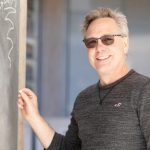OBSERVATIONS GERALD SHADEL Explores stressed-out mitochondria
Inside Salk sat down with Shadel to find out how he became interested in mitochondria, what he is driven by scientifically and what he has learned about aging along the way.
When Gerald Shadel gives public talks, he likes to begin by posing a question to the audience. “Who remembers what mitochondria are?” he prompts. “The powerhouse of the cell!” people tend to respond in enthusiastic unison.
Mitochondria have that memorable moniker for their role in converting carbohydrates and fats in our food into a high-energy chemical called ATP, which fuels all the activities in our cells.
Because of that fundamental metabolic role, mitochondrial dysfunction is associated with many common diseases, including cancer, heart disease, diabetes, autoimmunity and neurodegeneration (also known as dementia). And underpinning them all is aging, whose pathologies–such as hearing loss or muscle wasting–closely overlap with those of mitochondrial diseases. By studying mitochondrial function in both disease and health, Shadel seeks to gain insights into both aging and longevity.
How did you begin studying mitochondria?
For my PhD, I studied a form of communication in bacteria called quorum sensing, which is regulated by a unique gene-expression circuit. For my postdoctoral studies, I wanted to move into more complex organisms. I guess I sort of stopped halfway and decided to study mitochondria in yeast and human cells. Mitochondria are basically bacteria within our cells, being derived from an ancient bacterium billions of years ago, with their own DNA called mtDNA. I continue to study how the genes in this mtDNA are expressed, but the majority of my lab is now working on how stressed-out mitochondria are involved in diseases, aging and the immune system in mammals.
In early 2018, you were recruited to Salk from Yale University via the Rockstar Fund. What drew you to the Institute?
One of my long-standing interests is in the molecular mechanisms of aging. Yale is a great place, and I was the director of the Center for Research on Aging there. But when I was deciding whether to come to Salk, I asked myself, “What is it I would do at Salk that’s new?” I knew about the Institute’s strength in neurobiology, and mitochondria are clearly involved in age-related neurodegeneration, so I saw it as an opportunity to get into that research space. The Salk community has really embraced me. It’s clear they want me to forge into new areas, and I already feel like an integral part of what’s going on here. I am especially excited to be involved, along with nine other Salk investigators, in the $19.2 million American Heart Association-Allen Initiative grant on aging and Alzheimer’s disease.
That sounds pretty ambitious. Will you have time for other projects?
It is ambitious, but it is a collaborative effort between many labs. Simultaneously, I will pursue multiple other research fronts. In my lab, I have an awesome group of dedicated people who are all smart, work hard and work well together. We have a new way of thinking about the role of mitochondria in aging and disease that has to do with molecules known as reactive oxygen species, which are toxic by-products of the process by which mitochondria make ATP. These molecules are normally thought of as being damaging to cells, but my lab is finding they actually have a second function, which is to act as signaling molecules that can lead to beneficial adaptive responses.
So a normally toxic by-product of the cell can be beneficial? How does that work?
Reactive oxygen species are “oxidants.” You’ve probably heard of antioxidants; these are enzymes or compounds that counter the effects of oxidants. Aside from getting antioxidants from food (such as fruit) or supplements, our bodies also make them. My lab actually developed a model in which we can turn off antioxidant production in mitochondria in a reversible way. This allows us to induce mitochondrial oxidant stress for a controlled time window and ask what adaptive changes occur.
Compared to cells that saw no stress, those that experienced a little mitochondrial stress responded by remodeling mitochondria to produce fewer reactive oxygen species and were resistant to a second oxidant challenge. In other words, the cellular version of “What doesn’t kill you makes you stronger.”
What else are you working on?
I have an exciting new project with my wife, Susan Kaech [Kaech is the director of Salk’s NOMIS Center for Immunobiology and Microbial Pathogenesis]. We just received a grant to look at the role of mitochondria in melanoma. Sue studies cancer immune responses and immunotherapy, and we want to manipulate mitochondrial function in both tumors and immune T cells and see how this affects tumor immune responses.
My lab also has ongoing investigations into how mitochondrial DNA promotes inflammation and contributes to aging and diseases. These studies are based on a 2015 paper we published, showing that when the mitochondrial DNA you inherit from your mother gets released from mitochondria into the rest of the cell, it triggers an inflammatory, antiviral, innate immune response. There is now an explosion of activity in this area, whereby mitochondrial DNA and other constituents from mitochondria trigger inflammation and associated diseases.
With this many projects, do you get to enjoy any time outside the lab?
I have three daughters. Two still live at home (fifth and sixth grade), and when Sue and I aren’t working, we spend the rest of our free time together as a family. Part of our negotiation with the girls to move to San Diego was to get a dog, so we have a new German Shepherd we like to take hiking or to one of San Diego’s many dog beaches.
Do you ever bring your daughters to Salk?
Before we brought them to visit the Institute for the first time, we told them about the great architecture. Once they saw it, they said, “Looks like cement with holes in it. When are they going to finish it?”
They’ve been to a few events like the Salk Science & Music concerts, and they like to come and draw on the whiteboards in my study and office. Then they came to the ceremony when Sue and I received our endowed chairs, and after all the pomp and circumstance was over they said, “All this was for a chair? It’s an actual chair?”
Any last thoughts?
At Salk, the faculty get a lot of airplay, and thus I think we often do not give enough credit to the students, postdocs and staff that are the real driving force of the science. I get a lot of gratification out of seeing them succeed and move on to have careers and trainees of their own. It’s a very satisfying feeling.
Support a legacy where cures begin.
Featured Stories
 Gerald Shadel explores stressed-out mitochondriaInside Salk sat down with Shadel to find out how he became interested in mitochondria, what he is driven by scientifically and what he has learned about aging along the way.
Gerald Shadel explores stressed-out mitochondriaInside Salk sat down with Shadel to find out how he became interested in mitochondria, what he is driven by scientifically and what he has learned about aging along the way. The science of agingWhat we know about longevity so far: Minimizing smoking, obesity and overeating while maximizing exercise and social interactions seem to correspond to longer and healthier lives, but not always. While many factors have been touted as panaceas for extending life–everything from adhering to a Mediterranean diet to regularly imbibing red wine–a “fountain of youth” has remained stubbornly elusive.
The science of agingWhat we know about longevity so far: Minimizing smoking, obesity and overeating while maximizing exercise and social interactions seem to correspond to longer and healthier lives, but not always. While many factors have been touted as panaceas for extending life–everything from adhering to a Mediterranean diet to regularly imbibing red wine–a “fountain of youth” has remained stubbornly elusive. Lillian Eichner: Reading the clues to fight cancerEichner began studying cancer while pursuing her PhD at McGill University in Montreal. She was drawn to the Salk Institute for her postdoctoral studies because Reuben Shaw, director of the Salk Cancer Center and a professor in Salk’s Molecular and Cell Biology Laboratory, has taken a new approach to cancer by studying the metabolic pathways of deadly tumors.
Lillian Eichner: Reading the clues to fight cancerEichner began studying cancer while pursuing her PhD at McGill University in Montreal. She was drawn to the Salk Institute for her postdoctoral studies because Reuben Shaw, director of the Salk Cancer Center and a professor in Salk’s Molecular and Cell Biology Laboratory, has taken a new approach to cancer by studying the metabolic pathways of deadly tumors.



















































